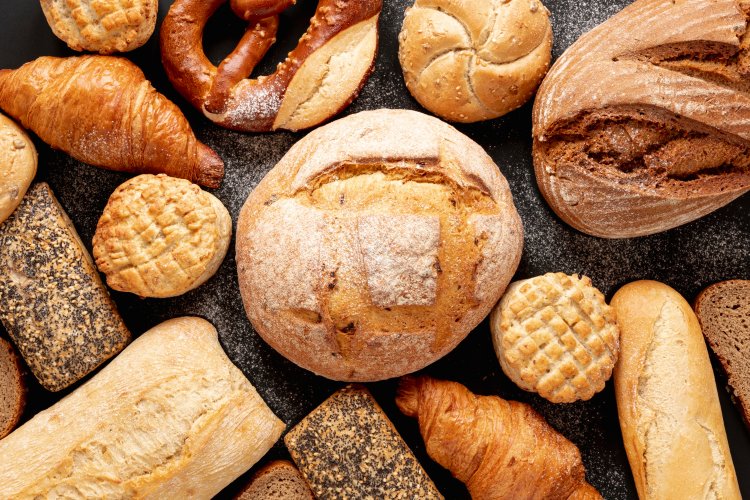From Ancient Grains to Modern Delights: The Story of Bread
Bread, a fundamental foodstuff enjoyed globally, holds a rich history dating back millennia. It is crafted from basic ingredients such as flour, water, yeast (or leavening agents), and salt, each contributing to its varied textures, flavors, and forms.

History of Bread
The origins of bread-making trace back to ancient civilizations, notably in Egypt around 10,000 years ago. Initially, flatbreads were fashioned by baking dough made from ground grains and water on hot stones or in rudimentary ovens. The innovation of leavened bread marked a significant advancement with the discovery of yeast, allowing dough to ferment and rise, resulting in softer, lighter loaves. Bread has transcended its humble beginnings to become a symbol of sustenance, culture, and tradition worldwide, playing pivotal roles in religious ceremonies, social gatherings, and economic systems throughout history.
Types of Bread
Leavened Bread:
- White Bread: Crafted from refined wheat flour, often enriched with added nutrients.
- Whole Wheat Bread: Derived from whole grain wheat flour, retaining higher fiber content and essential nutrients.
- Sourdough: Known for its tangy flavor and chewy texture, achieved through natural fermentation using wild yeast and bacteria.
- French Bread: Characterized by its crispy crust and soft interior, typically made with minimal ingredients.
Flatbread:
- Pita: A staple in Middle Eastern cuisine, known for its pocket-like structure ideal for sandwiches and dipping.
- Naan: Traditional Indian bread baked in a tandoor oven, often served with curries or used as a wrap.
- Tortilla: A versatile staple in Mexican cuisine, made from corn or wheat flour and used for tacos and burritos.
Sweet Bread:
- Brioche: Rich and buttery with a hint of sweetness, commonly used for pastries and desserts.
- Banana Bread: Moist and flavorful, made with mashed bananas and often complemented by nuts or chocolate chips.
Nutritional Value of Bread
Bread serves as a significant source of carbohydrates, the body's primary energy source. Whole grain varieties additionally provide dietary fiber, essential minerals such as iron and magnesium, and B vitamins including folate and niacin. Opting for whole grain and artisanal breads over processed alternatives enhances nutritional benefits, supporting overall health and well-being.
Health Benefits of Bread
Consuming bread, particularly whole grain options, offers several health advantages:
- Energy Boost: Carbohydrates in bread provide readily accessible energy.
- Digestive Health: Fiber content aids digestion and promotes satiety.
- Nutrient Density: Essential vitamins and minerals contribute to overall nutritional intake, supporting various bodily functions.
Culinary Uses of Bread
Bread's versatility extends beyond mere sustenance, serving as a cornerstone in culinary endeavors:
- Sandwiches: A ubiquitous base for assembling diverse fillings, from simple cheese and vegetables to elaborate meats and sauces.
- Croutons: Cubes of toasted or fried bread used to garnish salads or soups, adding texture and flavor.
- Breadcrumbs: Used as a coating for fried or baked dishes, enhancing crispiness and taste.
- Desserts: Utilized in puddings, bread puddings, and as a base for sweet pastries and cakes.
Cultural Significance
Beyond its nutritional and culinary roles, bread carries profound cultural symbolism:
- Religious Rituals: In Christianity, bread symbolizes the body of Christ during Holy Communion.
- Social Customs: Sharing bread signifies hospitality and communal bonds across diverse cultures.
- Historical Impact: Bread prices historically influenced social movements and economic stability, highlighting its economic significance.
Bread Production
Modern bread production combines traditional techniques with mechanized processes, ensuring consistency and efficiency. Key stages include mixing, fermentation, shaping, proofing, baking, and cooling, each crucial in determining the final characteristics of the bread produced.
In conclusion, bread transcends its status as a mere foodstuff to embody cultural heritage, nutritional sustenance, and culinary versatility across civilizations. From ancient flatbreads to artisanal sourdoughs, its evolution reflects human ingenuity and adaptation. Embracing diverse bread varieties not only enriches culinary experiences but also underscores its enduring significance in shaping dietary habits, cultural practices, and societal norms worldwide.
Disclaimer: The information provided in this article is for educational purposes only and should not be considered medical advice. If you have any health concerns or are experiencing symptoms, it is important to consult with a healthcare professional, such as a doctor or clinic, for proper diagnosis and treatment. Always seek the advice of your doctor or other qualified health provider with any questions you may have regarding a medical condition. Do not disregard professional medical advice or delay in seeking it because of something you have read in this article.
#breadhistory #breadtypes #healthbenefitsofbread #breadnutrition #culinaryusesofbread #culturalsignificanceofbread #breadproduction #sourdough #flatbread #wholegrainbread
What's Your Reaction?





















